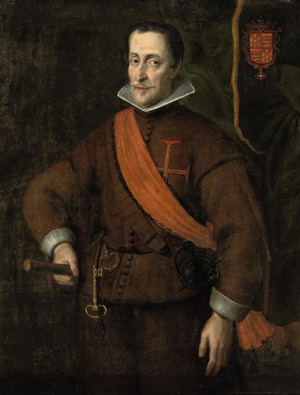Manuel de Moura Corte Real, 2nd Marquis of Castelo Rodrigo facts for kids
Quick facts for kids
Manuel de Moura
|
|
|---|---|
 |
|
| Born | 1590 |
| Died | 28 January 1651 (aged 60) |
| Title | Marquis of Castelo Rodrigo |
| Spouse(s) | Leonor de Melo |
Dom Manuel de Moura Corte-Real, 2nd Marquis of Castel Rodrigo, (Archaic Portuguese: Manoel de Moura e Côrte-Real), (1590 – 28 January 1651), was an important Portuguese nobleman. He was known as the 2nd Marquis of Castelo Rodrigo. He served as the Governor of the Habsburg Netherlands from 1644 to 1647. This was a powerful position in what is now Belgium and parts of the Netherlands.
Contents
A Noble Family's History
Manuel de Moura e Corte Real was the second of three marquises with the title Castelo Rodrigo. His family was Portuguese, from Lisbon, even though they worked for the King of Spain.
Family Roots and Loyalty
His father's family came from Moura, a town in Portugal. They helped take it back from the Moors in 1165. The family became very rich in the late 1500s. Manuel's grandfather, Cristóvão de Moura, supported the Spanish king, Philip II. Philip II wanted to be king of Portugal during the 1580 Portuguese succession crisis. This event led to the Iberian Union, where Spain and Portugal were ruled by the same king. Manuel's mother was the leader of the Corte-Real family.
Manuel's Family Life
Manuel de Moura e Corte Real married Leonor de Melo. Their oldest son, Francisco de Moura, was born in 1610. Francisco later became the third Marquis of Castelo Rodrigo. Like his father, he also became governor of the Southern Netherlands.
Manuel's Career and Diplomacy
Manuel started working for the Habsburg kings of Spain in 1615. He was a Gentleman of the Chamber for the prince who would become Philip IV. When Philip IV became king in 1621, Manuel was not given a big role at first. This was because of a rival, Gaspar de Guzmán, Count-Duke of Olivares, who was the king's favorite.
Important Missions
In 1627, Castelo Rodrigo was sent back to Lisbon to prepare a fleet of ships. He was called back to court in 1630. Olivares decided to use Manuel's skills for important diplomatic work. Manuel was made ambassador to Rome. While there, he supported famous artists like Borromini and the sculptor François Duquesnoy.
Loyalty During Revolt
Manuel's time as ambassador ended when Portugal revolted in December 1640. Portugal wanted to be independent from Spain again. Manuel stayed completely loyal to the Spanish king. He lost many family lands in Portugal because of this. Even so, it was difficult for a Portuguese person to be a Spanish ambassador during the revolt. Olivares was also not fully sure of Manuel's loyalty.
Governor of the Netherlands
In 1642, Manuel was sent to Vienna, where he served until May 1644. From June 1644, he worked in Brussels as the assistant governor of the Netherlands. He worked hard to bring peace between the United Provinces and Spain. He was very important in the early talks that led to the peace conference of Münster. He served as King Philip IV's trusted minister until he was called back in 1647.
Later Life and Death
Castelo Rodrigo arrived in Madrid on January 14, 1648. In 1649, he held the position of Mayordomo mayor in the royal palace. This was a high-ranking role. A portrait, once thought to be by Velázquez, shows him looking dignified in his old age. He died in Madrid in 1651 when he was 61 years old.
See also
 In Spanish: Manuel de Moura y Corte-Real para niños
In Spanish: Manuel de Moura y Corte-Real para niños

